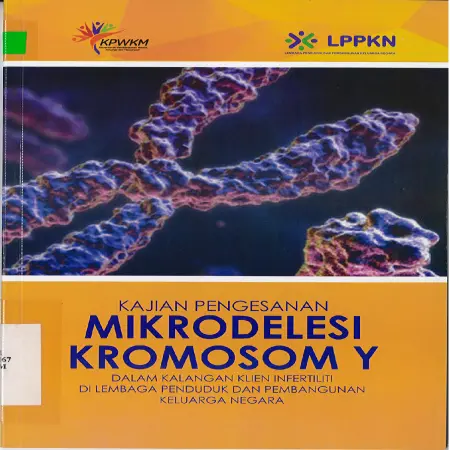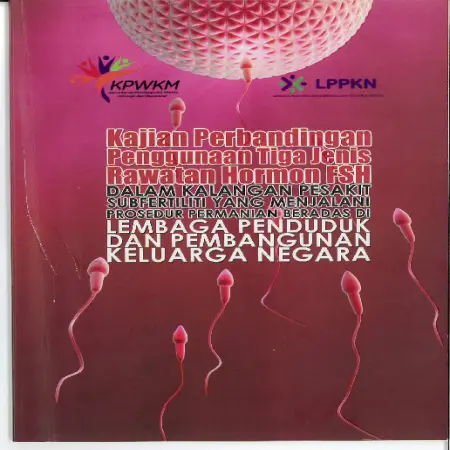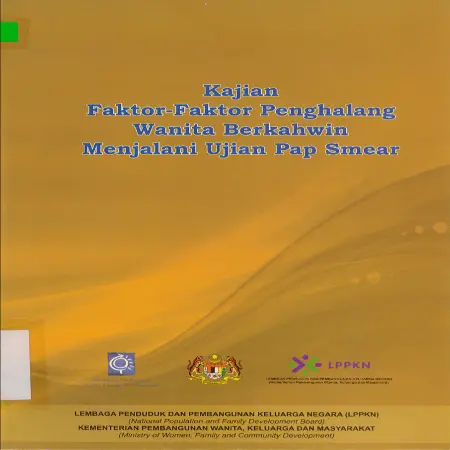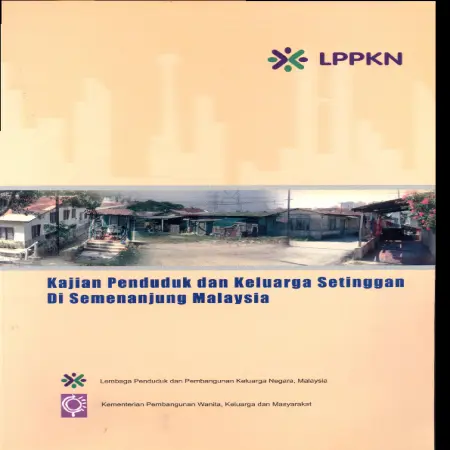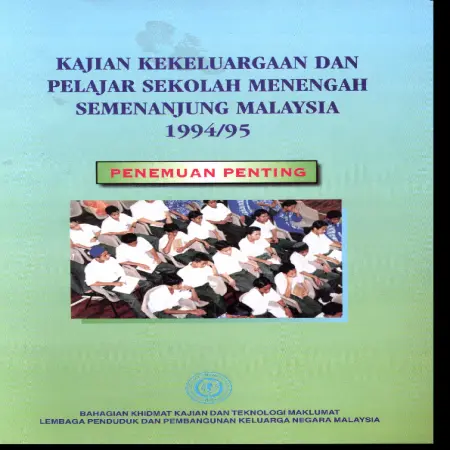Browse by Author
Results for Family Name : "Lembaga Penduduk dan Pembangunan Keluarga Negara, Malaysia"
|
|
K.A.S.I.H
Item Type: Video
Editor:
Year: 00/01/2023
Abstract: The Family KASIH campaign is an initiative of the Ministry of Women, Family and Community Development (MWFCD) through the National Population and Family Development Board (NPFDB) to deal with mental health problems among family members post-Covid-19. This campaign focuses on the application of pure family values which is LOVE which is the main core of family well-being. LOVE means Affection, Morality, Health and Safety, Knowledge and Harmony.
|
|
|
|
|
|
Kajian Pengesanan Mikrodelesi Kromosom Y dalam kalangan klien Infertiliti di Lembaga Penduduk dan Pembangunan Keluarga Negara
Item Type: Research Report
Editor:
Year: 02/01/2017
Abstract: The study "Microdelesi of Y Chromosome among NPFDB Infertility Clients" conducted by the Biomedical Unit, NFPDB is to identify infertility factors from a genetic aspect. Study samples were obtained from infertility patients referred to the Cytogenetic Laboratory, NPFDB from 2003 to 2010. A total of 100 blood samples of clients diagnosed as azoospermia (48), severe oligoasthenoteratozoospermia (24), oligozoospermia (15), severe oligozoospermia (6), Klinefelter Syndrome (3) and idiopathy (4) were performed Chromosome Analysis Tests to identify any abnormalities of the number and structure on the chromosome and subsequently Molecular Testing is performed to detect the microdeletion of the Y chromosome. Majority of ethnic groups involved in the study are Malays, which is 74 people (74%) followed by Chinese; nine (9) people (9%), Indians; seven (7) people (7%) and other ethnicities from Sabah and Sarawak as many as 10 people (10%) in the age range of 23 to 46 years.The chromosome analysis test results for the 100 samples were normal which is, 46, XY, no abnormalities in the structure or number of chromosomes were found. Results was found that 15 samples (15%) underwent Y chromosome microdeletion at the AZF locus in molecular test. From 15 samples, 10 samples were azoospermia, three (3) severe oligoasthenoteratozoospermia samples and two (2) oligozoospermia samples. Each sample experienced deletion at different locus and there were samples that experienced multiple deletion which involved deletion of more than one factor locus (AZF).The most common AZF factors found to experience deletion were AZFc (73.33%) followed by AZFb (53.33%), AZFd (40%) and AZFa (13.33%). In conclusion, it was found that genetic factors are one of the causes of infertility problems among clients came for subfertility treatment. Looking at the importance of undergoing genetic screening testing at an early stage, it is recommended that this test be tested for men diagnosed with azoospermia and severe oligozoospermia at the Subfertility Clinic, NPFDB. The information obtained has prognostic value and influences the medical therapy chosen to assist in the clinical management of the client and his descendant in the future.
|
|
|
|
|
|
Kajian perbandingan penggunaan tiga jenis rawatan hormon FSH dalam kalangan pesakit subfertiliti yang menjalani prosedur permanian beradas di Lembaga Penduduk dan Pembangunan Keluarga Negara
Item Type: Research Report
Editor:
Year: 02/01/2017
Abstract: Since 1979, the National Population and Family Development Board (NPFDB) has been providing subfertility management services to the public especially middle-income group. In line with the rapid pace of the latest technology and research developments, there are various types of fertility drugs in the form of injections which had been used in subfertility treatment. The main function of this injection is to mature the follicles where the main hormone contained in this injection is the follicle stimulating hormone (Follicle Stimulating Hormone, FSH). In general, there are three types of FSH injections, which is a recombinant FSH (rFSH) that have 100 percent synthetic hormone, urinary FSH (uFSH) that derived from menopausal urine and highly purified urinary FSH (hp-uFSH) that also derived from menopausal urine but more pure state than uFSH. All three hormones have FSH’s activities but uFSH and hp-uFSH also have Luteinizing Hormone’s activity (LH). Thus, NPFDB has taken initiative to conduct a comparative study on the use of three types of FSH hormone treatment, namely Gonal F (rFSH), Folliova (uFSH) and Menopur (hp-uFSH), among subfertilitie’s patient who’s undergoing Intrauterine Insemination Technique (IUI). Among others, the three types of hormones were studied in terms of effevtivenee and cost burden. The study sample was from patients with unknown cause of subfertilitie’s problem and they visit NPFDB Subfertilitie’s Clinic, Headquarters, from June 2010 to May 2012. The sampling method was random. The patient and researcher do not know the treatment regimen to be initiated until a closed sample containing the treatment regimen code number is opened by the patient before starting treatment. Data were collected, recorded and anlyzed using Statistical Package for the Social Sciences (SPSS) software. Although originally a total of 90 female patients were targeted to be recruited into this study. 30 patients for each type of FSH hormone, but at the end of the study only 39 patients met all eligibility criteria and agreed to participate in this study. The result showed that average of the patients was 28.3 years and the majority were ethnic Malays (76.9%). Most of the patients had a household income between RM 5,000.00 and RM 10,000.00 (51.4%). The percentage of patients requiring more than three injections to procedure mature follicles was lowest for Folliova (41.7%), compared with Menopur (50.0%) and Gonal F (55.6%). Similarly in terms of the number of follicles produced, the Folliova regime (58.3%) produced more follicles (more than three follicles) than other regimes. A total of 16.7 percent of patients who took Menopur injections were confirmed pregnant, while no pregnany occurred among patients who took Folliova and Gonal F. In terms of cost, at the time of this study, the price of three 75IU injections was RM 334.20 for Gonal F, RM 187.20 for Folliova and RM 271.20 for Menopur. In conclusion, this study shows that, hp-uFSH (Menopur) gives the highest pregnancy rate compared to Gonal F and Folliova. Furthemore, the price of Menopur is moderate (affordable) for patients. Therefore, highly purified urinary FSH is a good gonadotropin choice for couples with unexplained subfertility undergoing an IUI procedure and it may be the main choice for patients who need a combination fertility pill stimulation regimen and gonadotropin injections. As a suggestion, such a study should be conducted with a larger sample size to obtain more significant results and be representative of actual population.
|
|
|
|
|
|
Kajian Penduduk dan Keluarga Malaysia Kelima (KPKM-5)
Item Type: Video
Editor:
Year: 00/00/2014
Abstract: Announcement of the implementation of the Malaysian Population and Family Survey 2014 (MPFS-5).The purpose of this survey was to collect the latest information and time series data in respect of demography, family and reproductive health of the Malaysian population.
|
|
|
|
|
|
Kajian faktor-faktor penghalang wanita berkahwin menjalani ujian pap smear
Item Type: Research Report
Editor:
Year: 00/00/2010
Abstract: Cervical cancer is the second most dangerous threat to women that not only lead to a loss of pregnancy, but can even be life threatening. 12.9 percent of all cancer deaths among women are also due to this cancer. Unfortunately, 80% of women who are first diagnosed with cervical cancer are already at serious stage and cannot be treated properly even though cervical cancer screening programs such as Pap Smear have existed since 1943. Statistics released by the Ministry of Health Malaysia through the 2003 National Cancer Registry Report showed, even after the implementation of the Pap Smear program, the incidence rate of cervical cancer has increased where in 1990 the incidence rate was 13.3 per 100,000 women compared to 19.7 per 100,000 women in 2003. This illustrates that the Pap Smear program in Malaysia is not comprehensive and not practiced by those who need it which is women who have started sexual activity.
Therefore, the National Population and Family Development Board (LPPKN) has conducted a study in relation to cervical cancer screening or Pap Smear test. This study aimed to provide information on sociodemographic characteristics and reproductive history, women’s awareness on pap screening tests, women’s risk perceptions of cervical cancer, women’s attitudes towards the importance of Pap Smear testing and prevalence of Pap Smear screening test practice. This cross -sectional study was conducted in the Klang Valley, Melaka, Perak and Terengganu using purposive sampling. The total sample was 1000 people. The study population consisted of once married women aged between 20-65 years. This includes married women, widows and widowers. The conditions for rejecting the sample are ineligible women, such as unmarried women, non-Malaysian citizens and women who have had cervical cancer.
The collection of research data is through interviews based on the text of the questionnaire provided. Respondents will be interviewed by interviewers who have been trained to obtain accurate information. To achieve the objectives of the study, the analysis used is descriptive analysis, chi-square test and t test. Therefore, based on the analysis that has been conducted, the prevalence of female Pap Smear test is 55.2 percent. Respondents showed a positive attitude when asked about the importance of Pap Smear test compared to other examinations, many of whom thought that this test was very important (92.7 percent). Only 4.2 percent considered the Pap Smear test not important and there were a few who could not provide certainty about its importance (3.1 percent). Not many can measure the risk they are facing to get cervical cancer as 377 (41.5 percent) people are unaware of the cancer risk they are facing. However, there were a total of 276 (30.4 percent) women who were confident that they were not at risk at all. Only 7.7 percent received a high risk of this cancer, moderate risk (5.6 percent) and low risk (14.9 percent).
|
|
|
|
|
|
Kajian Penduduk dan Keluarga Setinggan di Lima Bandar Utama, Semenanjung Malaysia
Item Type: Research Report
Editor:
Year: 00/00/2001
Abstract: This study is to collect information on the population and squatter families from the demographic and socio-economic aspects. A total of 1.423 dwellings in slum areas has been carried out censorship. Of this amount, a total of 7.310 identified household members and 1,308 ever married women aged 15 to 49 years were selected. The study was conducted in five major cities in Peninsular Malaysia, namely, Ipoh, Sungai Petani, Petaling Jaya, Kuala Lumpur and Johor Bahru. The study covers the demographic information, housing and environmental conditions, the labor force participation, aspects of migration and relocation, neighborhood issues and community life, family interaction and communication between family members, reproductive health and health practices, child care issues, aspirations / hope respondents about their children's education in the future, and interaction respondent / husband with parents.
|
|
|
|
|
|
Kajian kesan pendatang asing ke atas penduduk tempatan: 'satu tinjauan di Mukim Setapak dan Ulu Kelang'
Item Type: Research Report
Editor:
Year: 01/12/2000
Abstract: This study was conducted to gather information on the impact of immigrants on the local aspect of demographic, economic, social, education, employment, health and safety. By using qualitative methods, fieldwork has successfully interviewed include locals, foreigners, government officials and community leaders. The study found that over 70 percent of respondents say that the locals immigrants chose Malaysia because of the economic opportunities and family ties with the local people. In addition, a stable political situation is also a cause of withdrawal immigrants into Malaysia. Almost half of the immigrants use the health facilities provided by the government. This causes the local population to resort to private clinics / hospitals that indirectly increase the cost of family expenses.
|
|
|
|
|
|
Kajian kekeluargaan dan pelajar sekolah menengah Semenanjung Malaysia 1994/95: penemuan penting
Item Type: Research Report
Editor:
Year: 00/00/1994
Abstract: This report summarized the key findings from the report of Family and High School Students Study conducted by the National Population and Family Development Board (NPFDB) in collaboration with the Ministry of Education, Malaysia in 1994. The study covered a total of 1089 students from levels two to five selected from 91 secondary schools in Peninsular Malaysia. Among the 535 students who were selected from those having a record of misconduct while the other 554 did not have a record of misconduct. This study also includes parents of students selected to obtain status information that can be related to the behavior of the students surveyed.
|
|
|
|







